
FIG. 59. A TETRAHEDRON. MAGNESIUM
CHAPTER VI
THE TETRAHEDRON GROUP B

FIG. 59. A TETRAHEDRON. MAGNESIUM
CHAPTER VI
THE TETRAHEDRON GROUP B
THESE ten elements occur on the right hand swing of the pendulum, on the outgoing and on the return swing. They are tetrahedrons in form, and their characteristic valence is four, although some of them are found to develop a higher valence of six. Fig. 59.
Although their fundamental form is the same as that of the Tetrahedron Group A, yet we find a distinctly different type of arrangement of the Anu in the funnels.
The same plan of four funnels opening on the faces of a tetrahedron is found in all these elements, but Magnesium and Sulphur have no central globe, and in Cadmium and Tellurium the globe becomes a cross.
ATOMIC ANU ELEMENT CENTRE 4 FUNNELS 4 SPIKES
NO.
12
432 Magnesium 4 (3 (3Mg12) ]
16
576 Sulphur 4 [3 (3516) ]
30
1,170 Zinc Zn18 4 [3 (3516) ] 4 [4Zn20+3Zn18'
+Cu10]
34
1,422 Selenium Zn18 4 [3 (3Se10+3Se10+3N2)
+
Se 153)]
48
2,016 Cadmium Cd48 4 [3 (3Se10+3Zn18'+4Zn20) )
52
2,223 Tellurium (Cd48 + 3) 4 [3 (3Se10 + 3Te21 + 4Te22) ]
(Te51)
63
2,843 Europium Eu59 4 [3 (3Se1O+3Eu26+4Eu31)]
67
3,004 Holmium Ho220 , 4 [3 (3Se10+3Eu26+4Eu31)]
80
3,576 Mercury Au864 4 [3 (3Se1O+3CI.19+4Te22)
+Se153]
84
3,789 Polonium Po405 4 [3 (3Po17+3Po33+4Po33') ]
ATOMIC NO. 12. MAGNESIUM
This element introduces us to a new arrangement of the internal structure of the funnels. Fig. 59.
Central globe. Magnesium is exceptional in having no central globe at all.
Funnels. Each funnel contains three segments of three ovoids. Each group of three ovoids forms a ring. The ovoids are all similar and consist of three small spheres of two, seven and three Anu respectively. Magnesium = 4 [3 (3Mg12)
4 funnels of 108 Anu = 432 Anu
Total = 432 Anu
Number weight i82 = 24.00
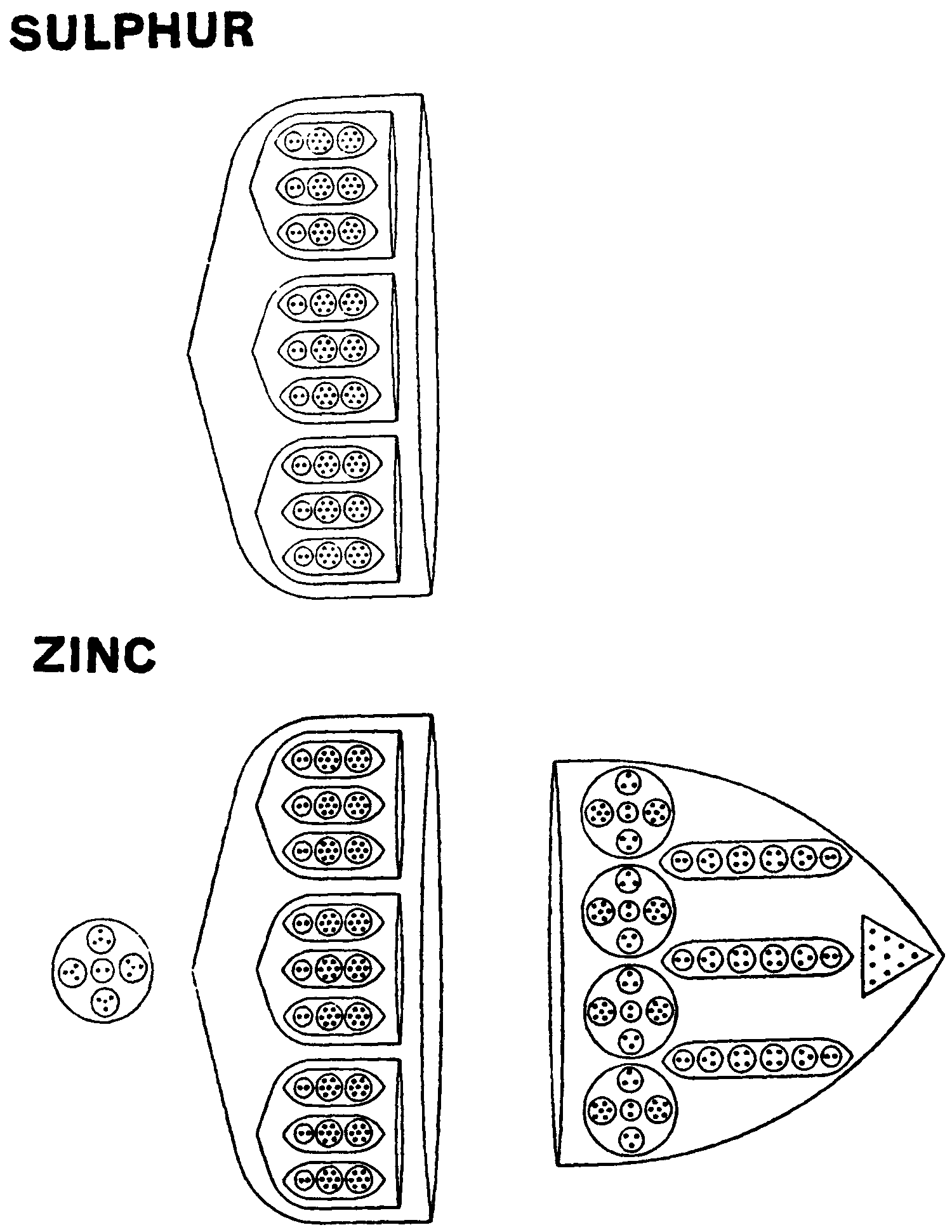
FIG.
60. SULPHUR, ZINC
THE TETRAHEDRON GROUP B 119
ATOMIC
NO. 16. SULPHUR
Central
globe. Sulphur, like Magnesium, has no central globe.
Funnels. The funnels of Sulphur are very similar to those of Magnesium, having three segments of three ovoids. The ovoids consist of three small spheres, a duad. N2, and two septets, 1.7, making S16. Thus 36 extra Anu are slipped into the funnels. Fig. 60.
Sulphur
= 4 [3 (3516) J
4
funnels of 144 Anu = 576 Anu
Total = 576 Anu
Number weight 5i8 = 32.00
ATOMIC
NO. 30. ZINC
Zinc
contains a globe and four spikes in addition to the four funnels. Funnels
and spikes alike radiate from a simple globe. Fig. 60.
Central
globe. The globe is made up of one N2 and four LA, making Zn18. These
five contained spheres are arranged cross-wise, preparing for the fully
developed cross of Cadmium. One end of the cross touches the bottom of
each funnel.
Funnels.
The funnels are identical with those of Sulphur, though they are more
compressed.
Spikes. The extra weight is mainly made up by the use of spikes, as was sometimes done in the previous group, The spikes show the cone of ten Anu, met with in other elements, and three very regular pillars, each with six spheres containing two, three, four, four three and two Anu respectively. The four supporting spheres, Zn20, are on the model of the central globe but contain two more Anu.
Zinc
= Zn18+4 [3 (3516) J+[4 Zn2O+3 Zn18'+Cu10]
Central
globe = 18 Anu
4
funnels of 144 Anu = 576
4 spikes of 144 Anu = 576 .,
Total = 1170 Anu
Number weight lib = 65.00
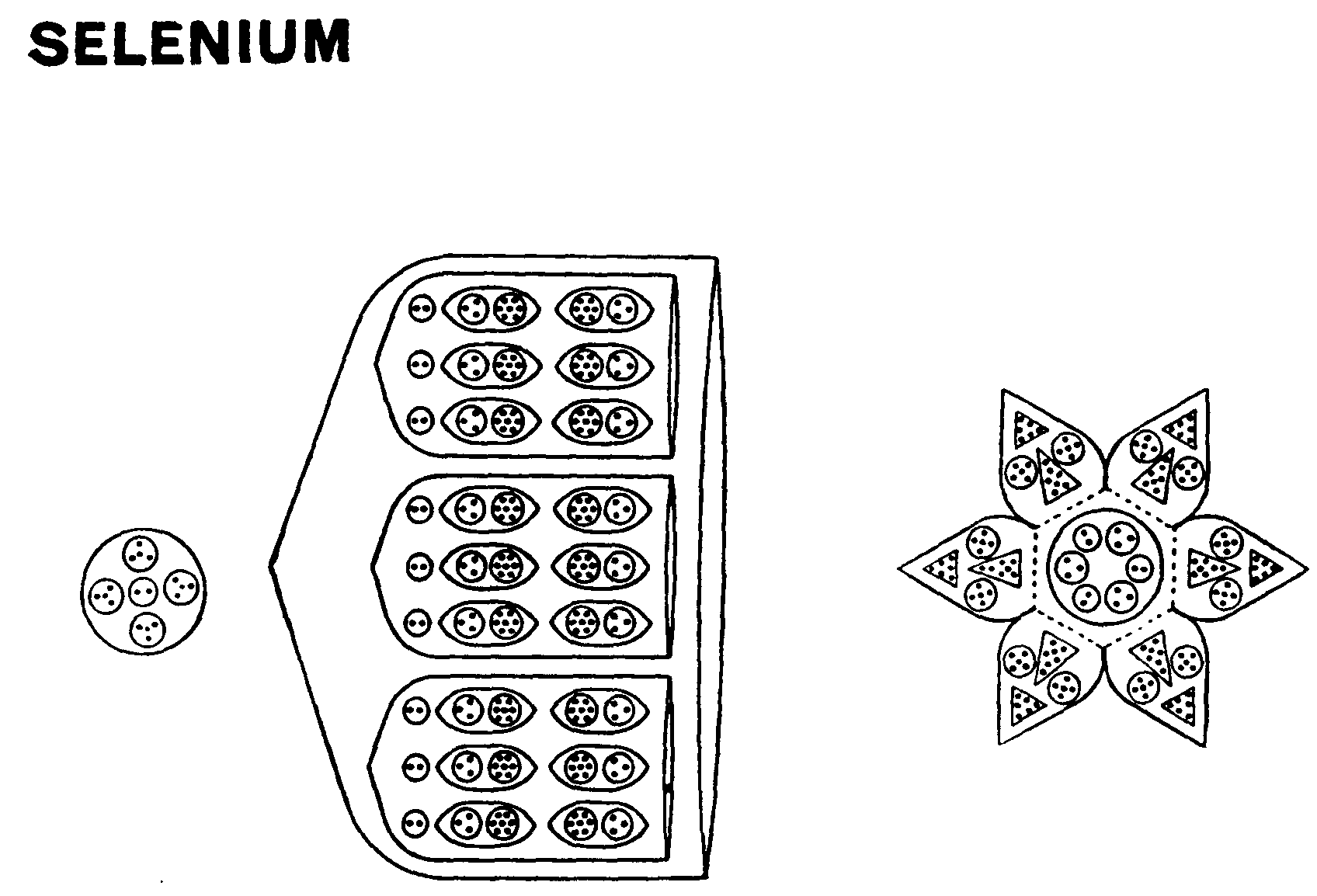
FIG.
61. SELENIUM
THE
TETRAHEDRON GROUP B 121
ATOMIC
No. 34. SELENIUM
Selenium
is distinguished by the peculiarity of an exquisite quivering star floating
across the mouth of each funnel and dancing violently when a ray of light
falls upon it. It is known that the conductivity of Selenium varies with
the intensity of the light falling upon it, and it may be that the star
is in some way connected with its conductivity. Fig. 61.
Central
globe. The central globe is the same as that of Zinc, Zn18.
Funnels.
The bodies in the funnels resemble those in Magnesium, but a reversed
image of the top one is interposed between this and the small duad, and
each pair has its own enclosure. There are three segments in the funnel
as usual.
The Star. It will be seen that the star is a very complicated body, having six points radiating from a central sphere. In each point the spheres of five Anu revolve around the cone of seven. Each star contains 153 Anu, Se153.
Selenium
= Zn18+4 [3 (3Se10+3Se10+3N2)+Se153]
Central
globe --- 18 Anu
4
funnels of 198 Anu == 792
4
stars of 153 Anu = 612 ,.
Total
= 1422 Anu
Number
weight ~ = 79.00
122
OCCULT CHEMISTRY
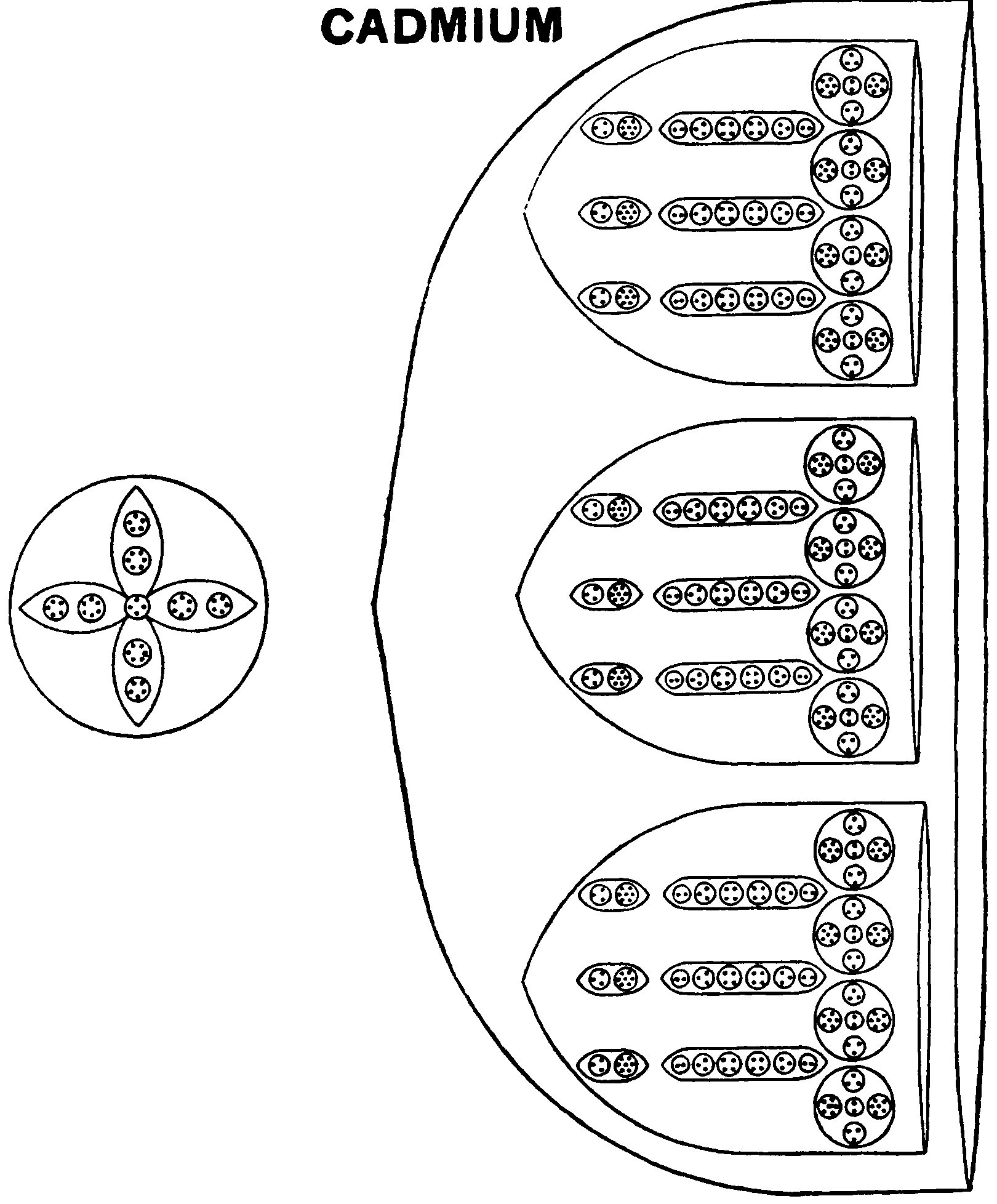
FIG.
62 CADMIUM
THE
TETRAHEDRON GROUP B 123
ATOMIC
NO. 48. CADMIUM
Globe.
The central globe is anew form, though prefigured in the central globe
of Zinc. It consists of nine small spheres arranged so as to form a cross,
Cd48. Fig. 62.
Funnels.
In Cadmium there are no spikes, but the three segments of the funnels
are much more complex than in Zinc.
Each of the three segments contains four spheres Zn20 and three pillars Zn18'. The pillars are similar to those in the zinc spikes. Below each of the pillars is an ovoid with ten Anu. This is the Se10 group found in the funnel of Selenium and which occurs frequently. Each segment of the funnel contains 164 Anu. hence the whole funnel contains 492 Ant.
Cadmium = Cd48+4 [3 (3Se10+3Zn18' + 3Zn20) J
Central
globe = 48 Anu
4
funnels of 492 Anu = 1968 _
Total = 2016 Anu
Number weight ~ - 112.00
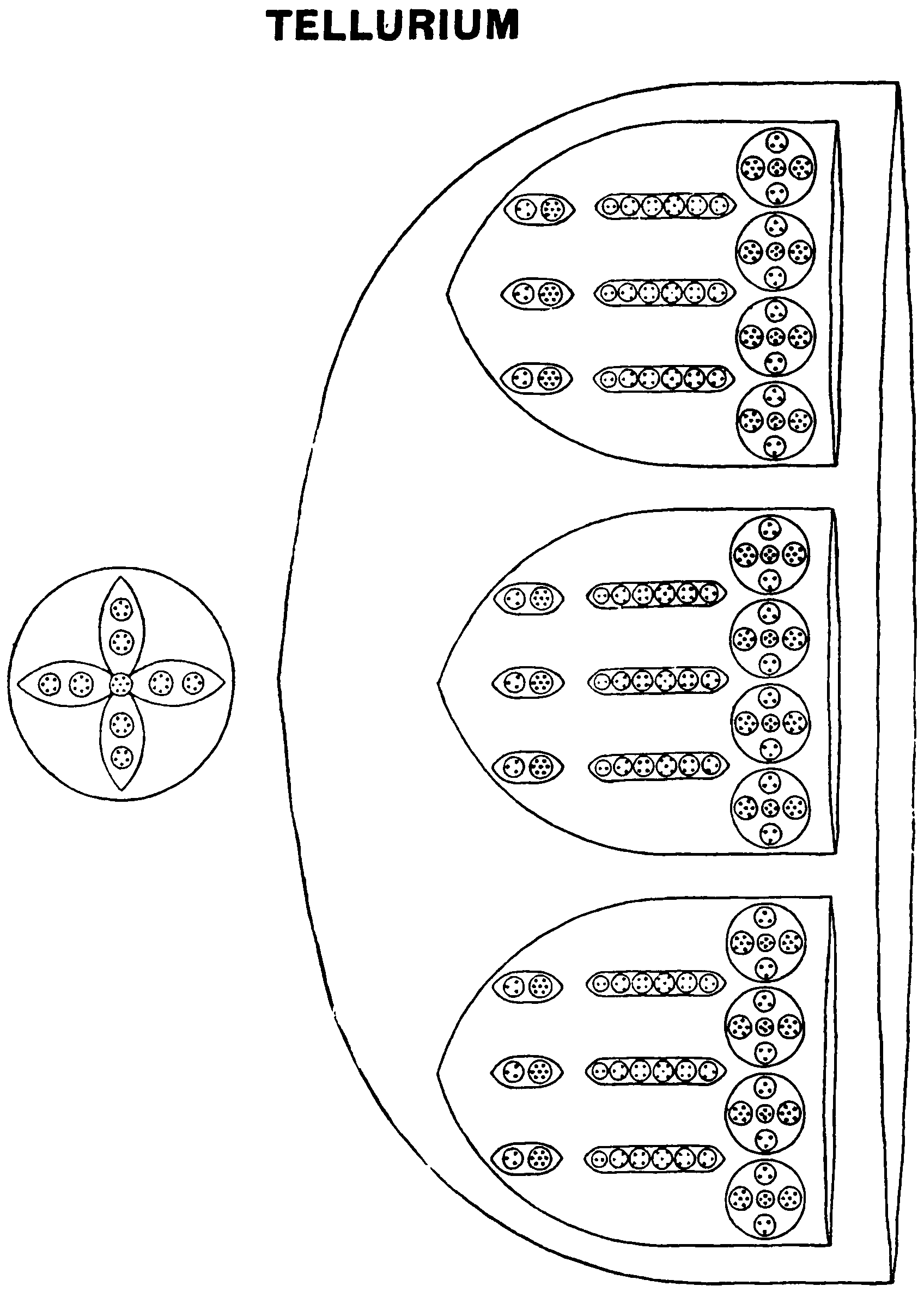
THE TETRAHEDRON GROUP B 125
ATOMIC No. 52. TELLURIUM
Tellurium, Fig. 63, closely resembles Cadmium.
Globe. The central cross which forms the globe differs from that of Cadmium in having a group of seven Anu at the centre instead of one of four. Cd48+3 a Te51.
Funnels. Tellurium has three cylindrical segments making up its funnel. The contained bodies in the pillars run two, three, four, five, four and three, making Te21. A quartet replaces a duad in the globes, making Te22. Below each pillar is a Se10 group. Each segment has 181 Anu.
Tellurium =(Cd48+3)+4 [3 (3Se10+3 Te21+4 Te22)
Central
globe = 51 Anu
4
funnels of 543 Anu = 2172 _
Total - 2223 Anu
Number weight ~3 = 123.50
Note: The number weight for Tellurium is lower than that usually accepted by science. If there were another variety in which the pillars were symmetrical, that is if another group of two Anu were added at the top of each pillar, the total Anu in this variety would be 2295 giving a number weight of 127.50.
126
OCCULT CHEMISTRY
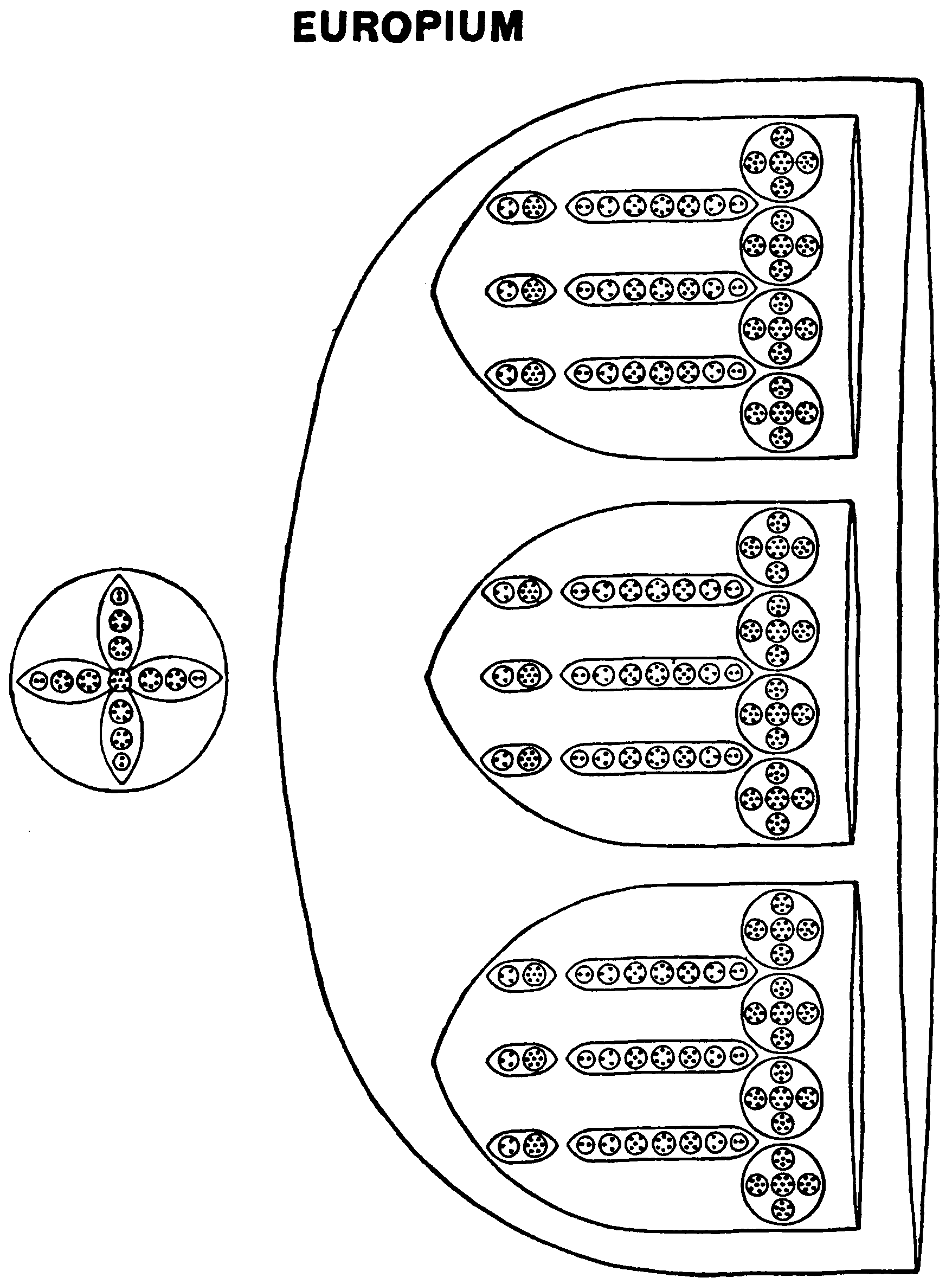
FIG.
64. EUROPIUM
THE TETRAHEDRON GROUP B 127
ATOMIC
NO. 63. EUROPIUM
This
element resembles Tellurium in its arrangement. Fig. 64.
Central
globe. The central globe of Europium is similar to that of Tellurium except
that a tiny sphere of two Anu is added to each arm of the cross. Thus eight
Anu are added to the globe of Tellurium, making Eu59.
Funnels. The funnels each consist of three identical segments, each of 232 Anu. Each segment contains, first the three Se10 as in previous elements, then three pillars each of 26 Amu, Eu26, and above these, four spheres, each Eu31. The total for one funnel is 696 Anu.
Europium
= Eu59+4 [3 (3Se10+3Eu26+4Eu31) ]
Central
globe = 59 Anu
4
funnels of 696 Anu = 2784
Total
= 2843 Anu
Number
weight ~ = 157.95
128
OCCULT CHEMISTRY
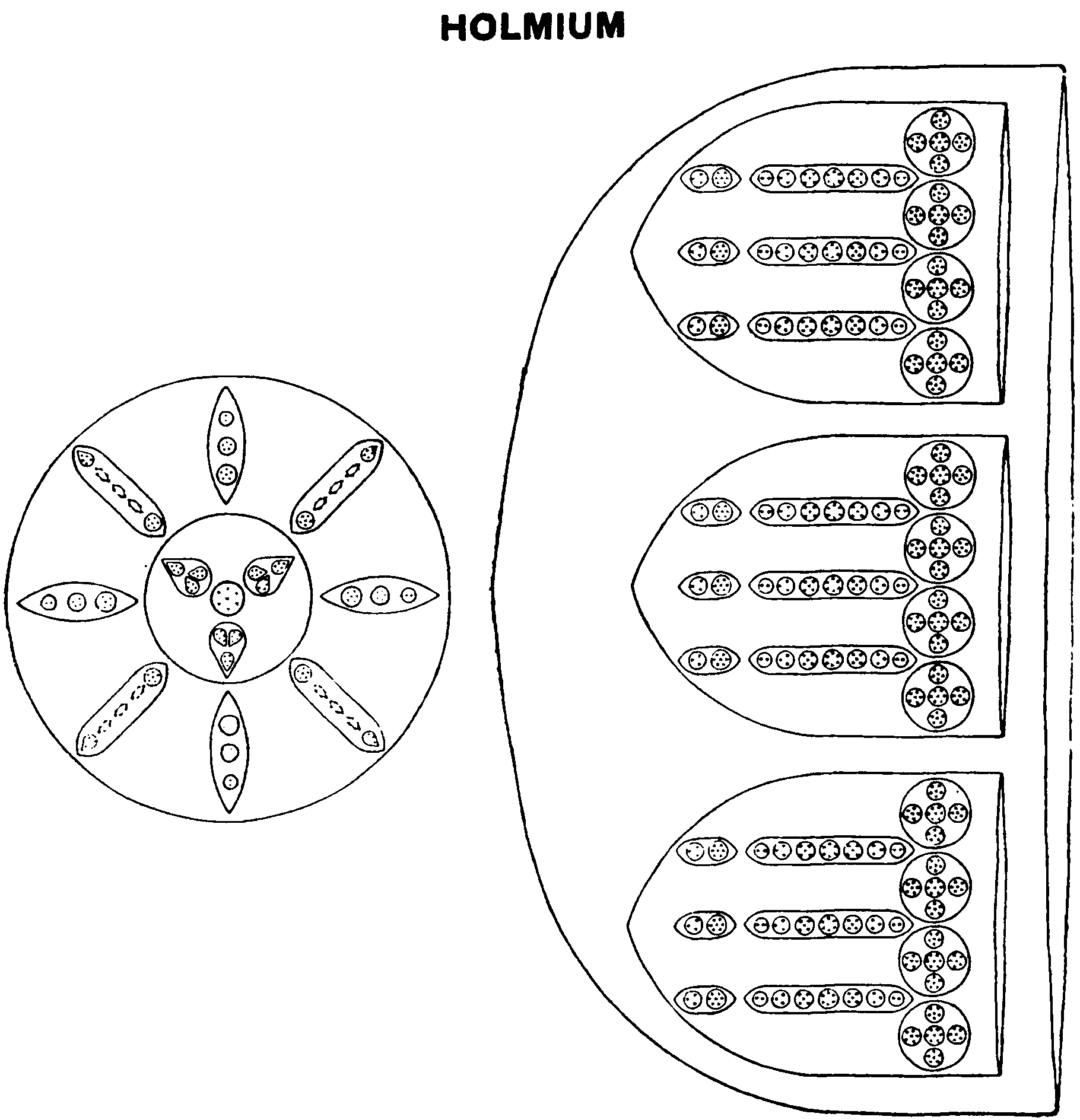
FIG.
65. HOLMIUM
THE TETRAHEDRON GROUP B 129
ATOMIC NO. 67. HOLMIUM
This element is similar to Europium except that its central globe is much more complex. Fig. 65.
Central globe. The grand centre of the globe is made up of a sphere of seven Anu. surrounded by three groups of 15 Anu. The seven central Anu are arranged at the six points of space with one in the centre.
The groups of 15 Anu suggest the rings in Occultum, Oc15.
Outside this sphere there radiate groups of bodies composed of two sets of four similar groups. Each set of four points in a definite direction fixed by the tetrahedron. One set of four points to the four faces and the other set to the four corners. The set that points to the four faces is that which occurs in the central globe of Europium.
In the set which points to the four corners each contains N6, three Ad6 and B5, some of which groups are found in Occultum. The B5 at the end comes to a point as if it were a prong.
When
we take the three groups of 3B5 and the remaining groups which make the
four pointers to the four corners, it is possible to account for three
Occultum atoms except for one Anu. When the three groups and the four pointers
were taken out they promptly rearranged themselves as three Occultum atoms.
It was found that the missing Anu was that which acted as the grand centre
of the whole Holmium atom.
Funnel. The four funnels are exactly as those in Europium. Each funnel has three segments and each segment contains 232 Anu arranged as in Europium.
Holmium
= Ho220+4 [3 (3Se10+3Eu26+4 Eu31)]
Central
globe = 220 Anu
4
funnels of 696 Anu = 2784
Total
= 3004 Anu
Number
weight ~ = 166.9
130
OCCULT CHEMISTRY
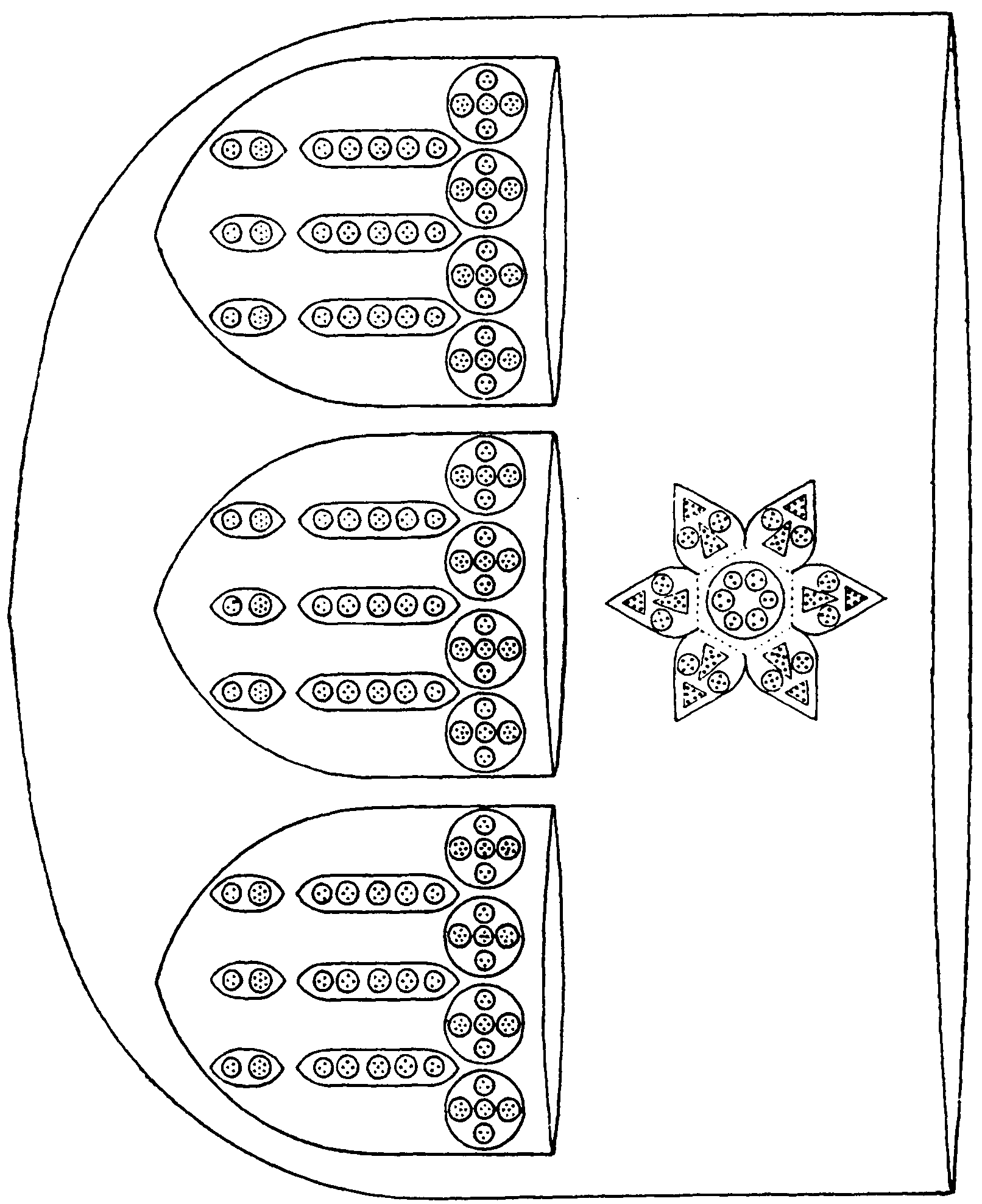
FIG.
66. THE FUNNEL OF MERCURY
THE TETRAHEDRON GROUP B 131
ATOMIC
NO. 80. MERCURY
Mercury
keeps to the tetrahedral form but adopts a much more complex central globe.
Figs. 66.67.
Here
we have an element with a decided individuality of its own. True, its component
parts are all borrowed, but the combination of them is unique.
Funnel.
Mercury borrows its funnels from Tellurium, though dropping two Anu
from each column, and then captures the lovely Selenium star, but turns
it into a solid looking and vigorously rotating sphere. The star is no
longer flat but has its arms projecting towards the six directions. We
may credit what is borrowed from Tellurium and Selenium to the type to
which all three belong, but what is taken from Gold must represent the
influence of the evolutionary force, since Gold comes just before it on
the spiral, though on quite a different line.
The funnels have three segments as in Cadmium. Each segment contains three Se10, three pillars, C1.19, and four globes Te22. Above the three segments there floats a sphere made of the Selenium star. Each funnel contains three segments-f-Se153, making 678 Anu.
132
OCCULT CHEMISTRY
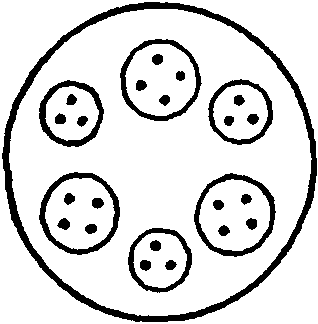
FIG.
67. THE CENTRE OF MERCURY
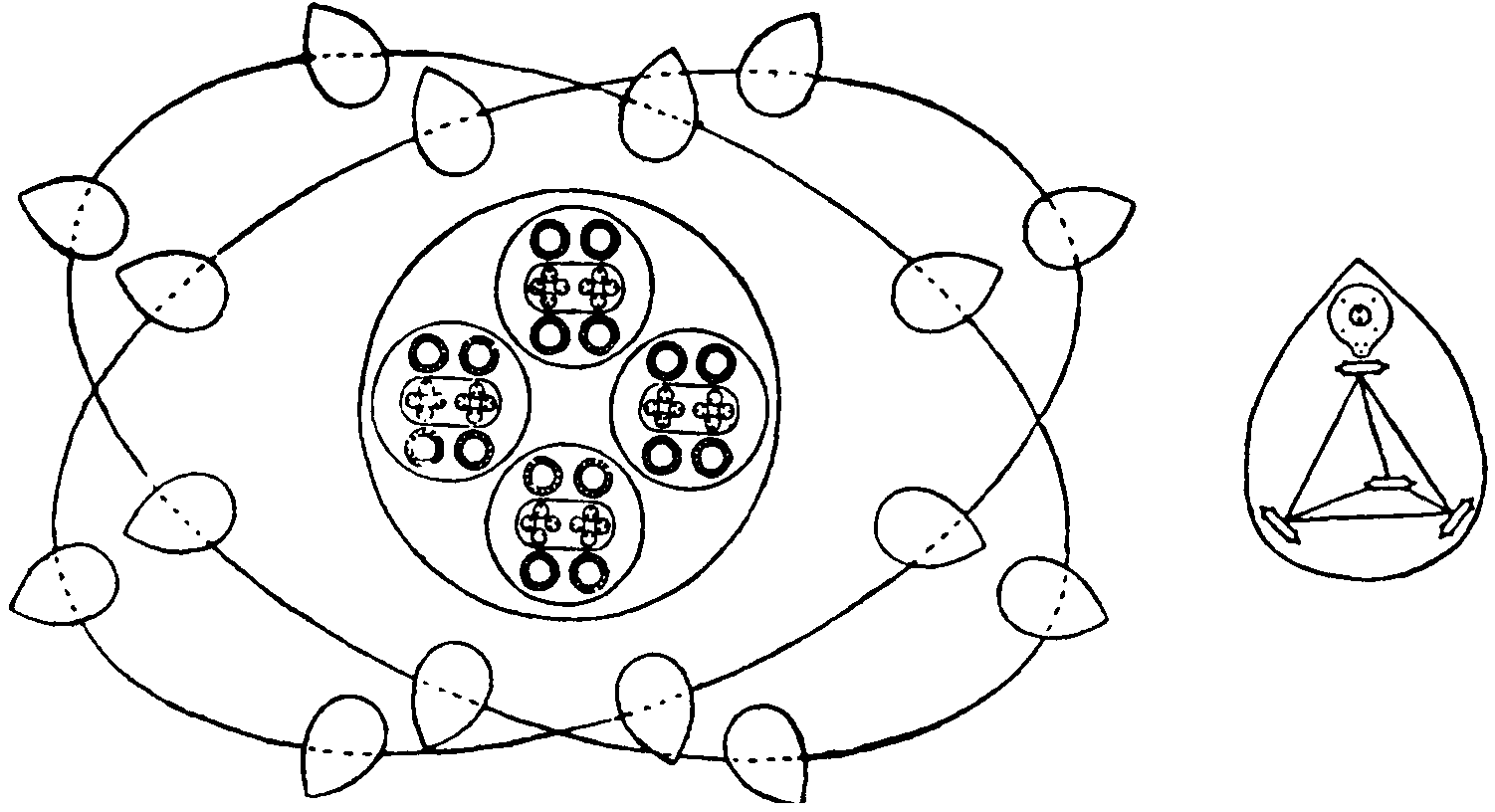
FIG.
68. CENTRE OF THE STAR IN THE FUNNEL OF MERCURY B
THE TETRAHEDRON GROUP B 133
The Central Globe. With splendid audacity, Mercury seizes upon the wonderful system of 864 Anu which makes the connecting rod in Gold, and uses that as its centrepiece. Fig. 67.
Mercury = Au864+4 [3 (3Se10+3CI.19+4Te22)+Sel53]
Central
globe -- 864 Anu
4
funnels of 678 Anu ---- 2712 _
Total -.= 3576 Anu
Number weight 3186 -- 198.66
An Isotope of Mercury. Mercury B is also a tetrahedron and closely resembles Mercury, the difference being only the addition of six Anu to each of the four funnels of Mercury. This produces a new element, a solid Mercury. A specimen of this rare form of Mercury exists in an occult museum.
The six extra Anu are added in the centre of the Selenium star in the
funnels. Fig. 69.
Mercury B.
Central globe = 864 Anu
4 funnels of 684 Anu - 2736 _
Total - 3600 Anu
Number weight ~ _ 200
134
OCCULT CHEMISTRY
ATOMIC
NO. 8s. POLONIUM
Polonium,
though a tetrahedron, is still heavier and more complicated than the earlier
members of the group. It is rare and appears to be unstable. Figs. 69,
70.
Central
globe. The globe goes back to the pattern of Holmium. It contains
a grand centre of a sphere 1.7 surrounded by six groups of (3B5) = Ho15.
This again is surrounded by eight groups as in Holmium. Four of these are
Po42 and four Po35, making a globe of 405 Anu as the centre-piece of Polonium.
Funnel. Each of the funnels has three segments. Each segment contains at the bottom three ovoids Po17, then three pillars Po33 and then four spheres Po33'. These make up 282 Anu. Three segments of 282 make 846 Anu in each funnel.
Polonium = Po405+4 (3 (3Pol7+3Po33+4Po33')]
Central globe = 405 Anu
4 funnels of 846 Anu =3384
Total = 3789 Anu78
Number weight 39 = 2105
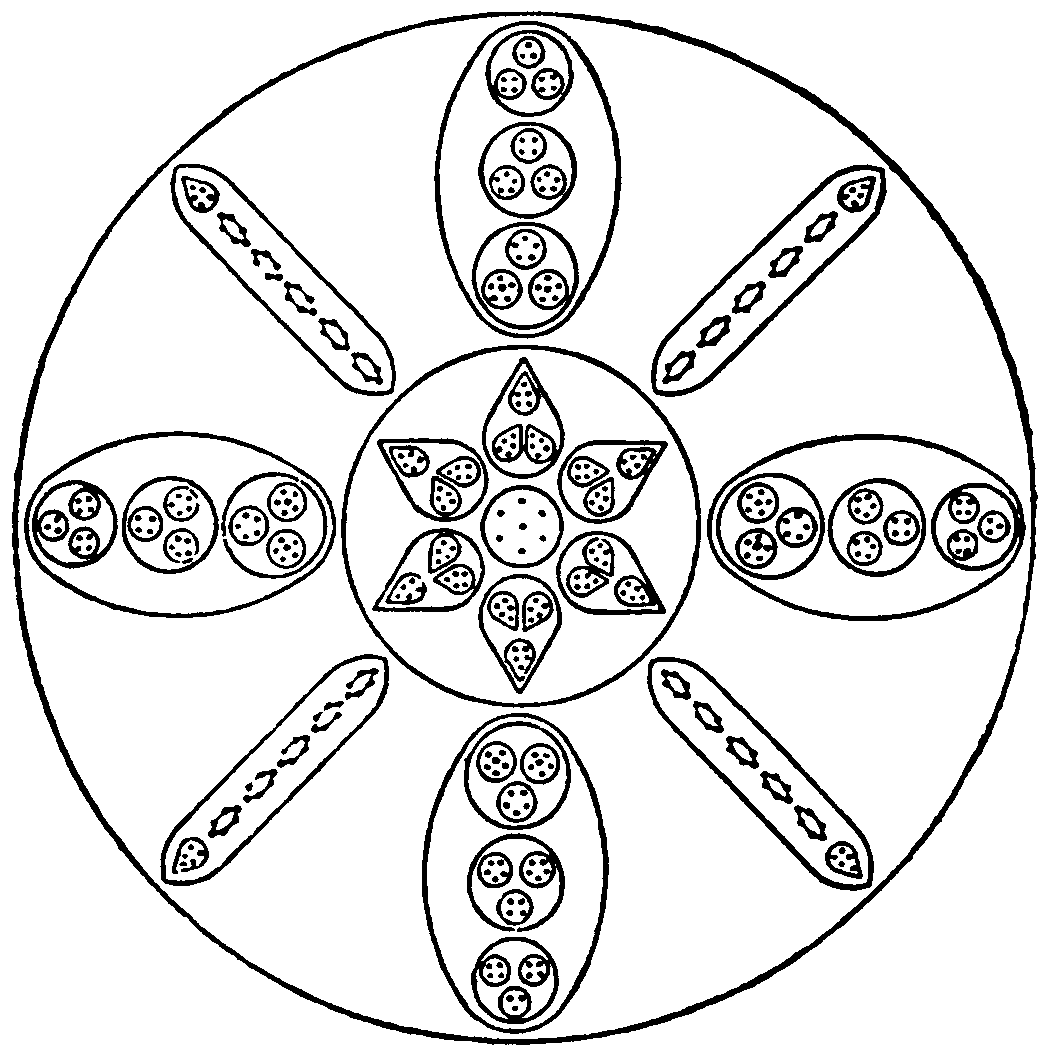
FIG.
69. THE CENTRE OF POLONIUM
THE
TETRAHEDRON GROUP B 135

OCCULT
CHEMISTRY
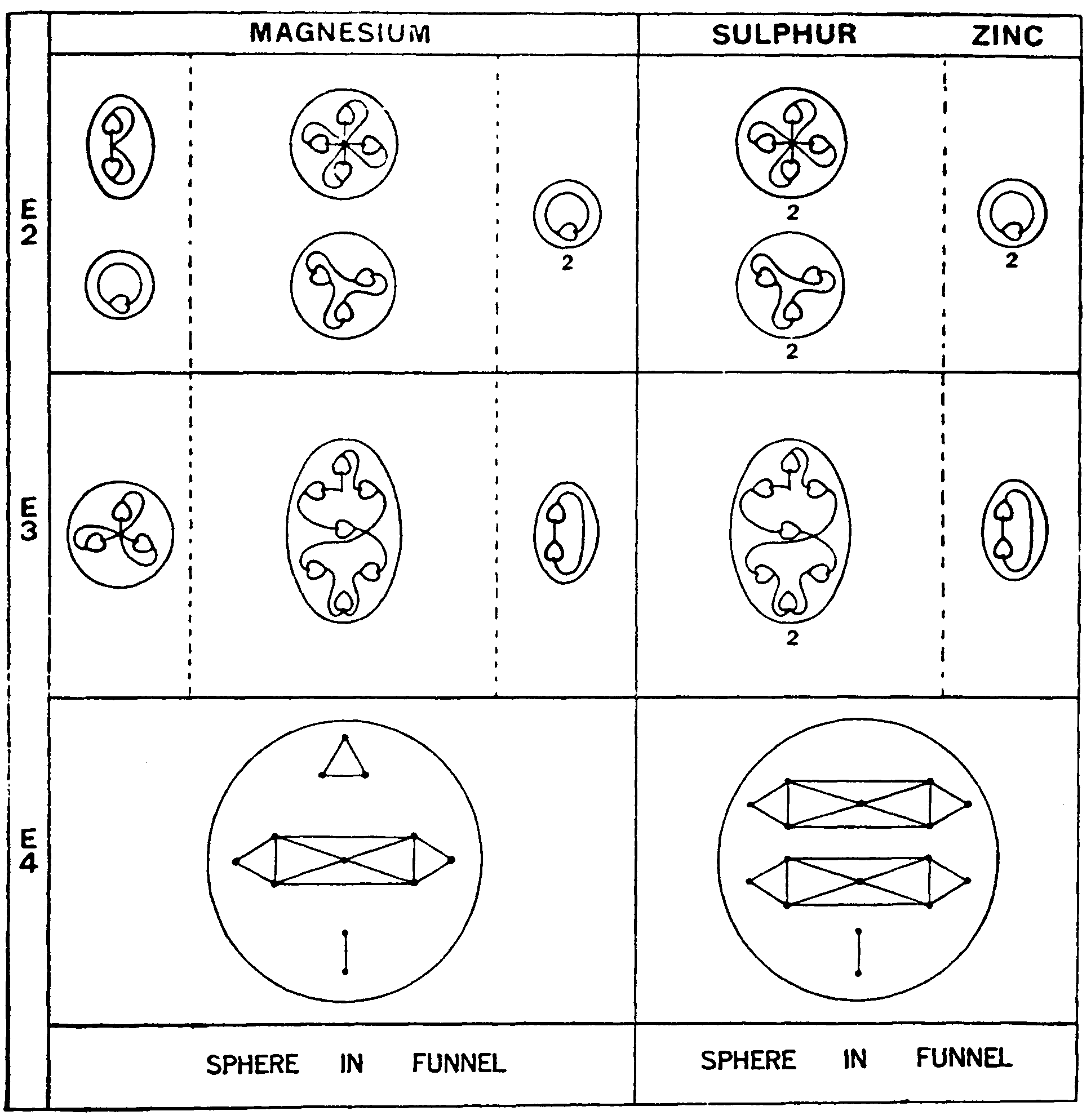
FIG.
71. DISINTEGRATION OF MAGNESIUM. SULPHUR AND ZINC
On the E3 level the three bodies in the sphere are set free, yielding a triplet, a septet and a duad.
On the E2 level the triplets become a dead and a unit, the septet gives a triplet and a quartet and the dead gives two units.
SULPHUR
This element has the same groups in the funnel as Magnesium, with the substitution of a second septet for the triplet. At the final disintegration on the E4 level we find, therefore, nine spheres from each funnel, each sphere containing two septets and a dead.
138 OCCULT CHEMISTRY
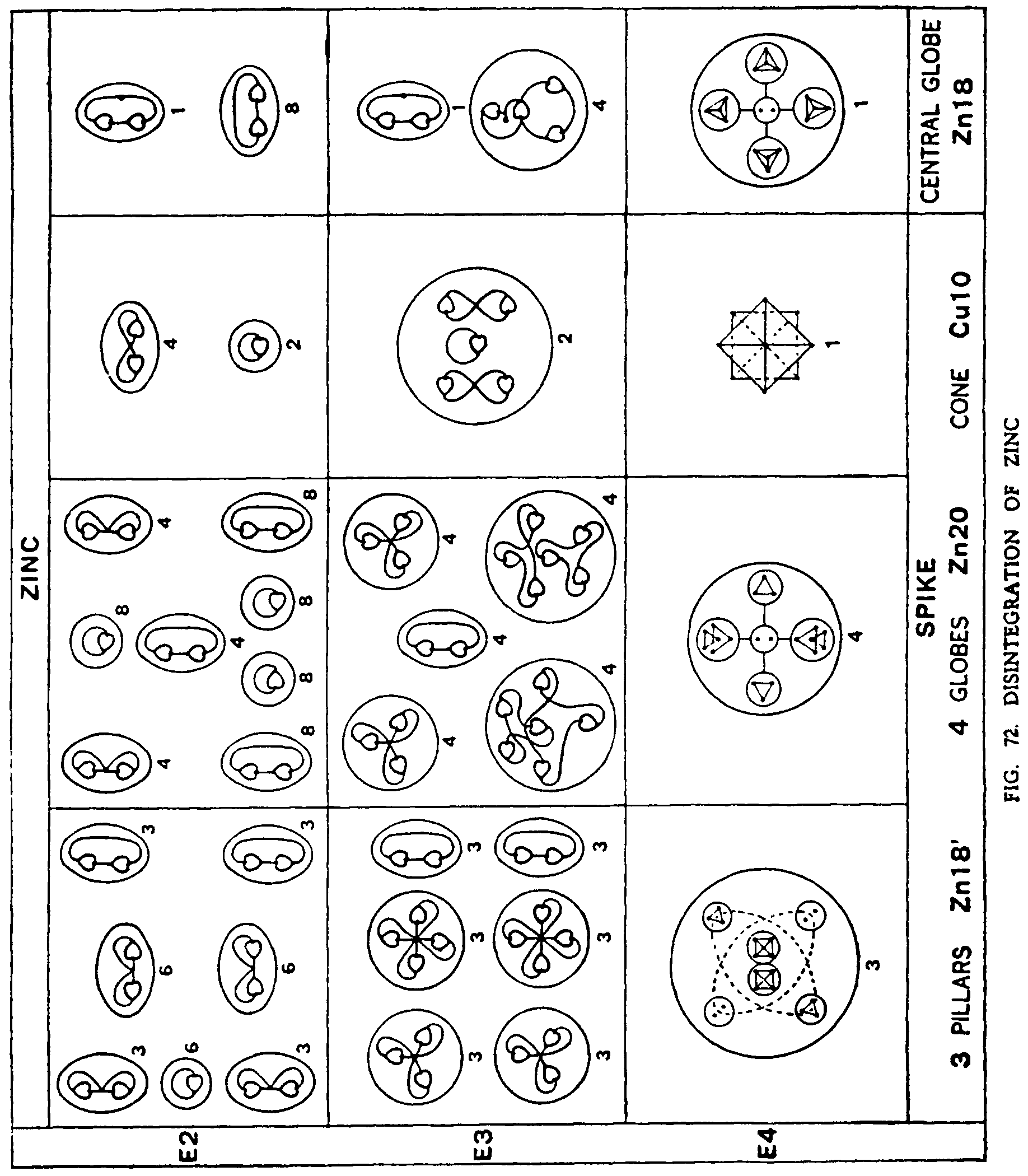
THE
TETRAHEDRON GROUP B 139
DISINTEGRATION OF ZINC
On
the E4 level the four funnels, the four spikes and the central globe are
first set free. Figs. 71, 72.
The
funnels are identical with those of Sulphur and behave in the same
way on disintegration.
The
spikes immediately release their contents, each spike giving eight
bodies, the three pillars Zn18', the four globes Zn20 and the cone Cu10.
The pillars Zn18' become globes. Each globe has six bodies revolving in
it in a rather peculiar way. The quartets turn round each other in the
middle; the triplets revolve round them in a slanting ' ellipse ; the duads
do the same on an ellipse slanting at an angle to the first, somewhat as
in gold. The globes Zn20 behave as a cross on the E4 level.
The
triangular arrangement at the top of the spike is the same as the cone
in Copper, Cu10.
The
further disintegration of these bodies is shown in Fig. 72.
The
central globe. Zn18 is set free on the E4 level and acts as a cross.
The cross is a favorite design in these groups.
On
the E3 level it forms four quartets and a dead.
On the E2 level it gives 9 duads.
110
OCCULT CHEMISTRY
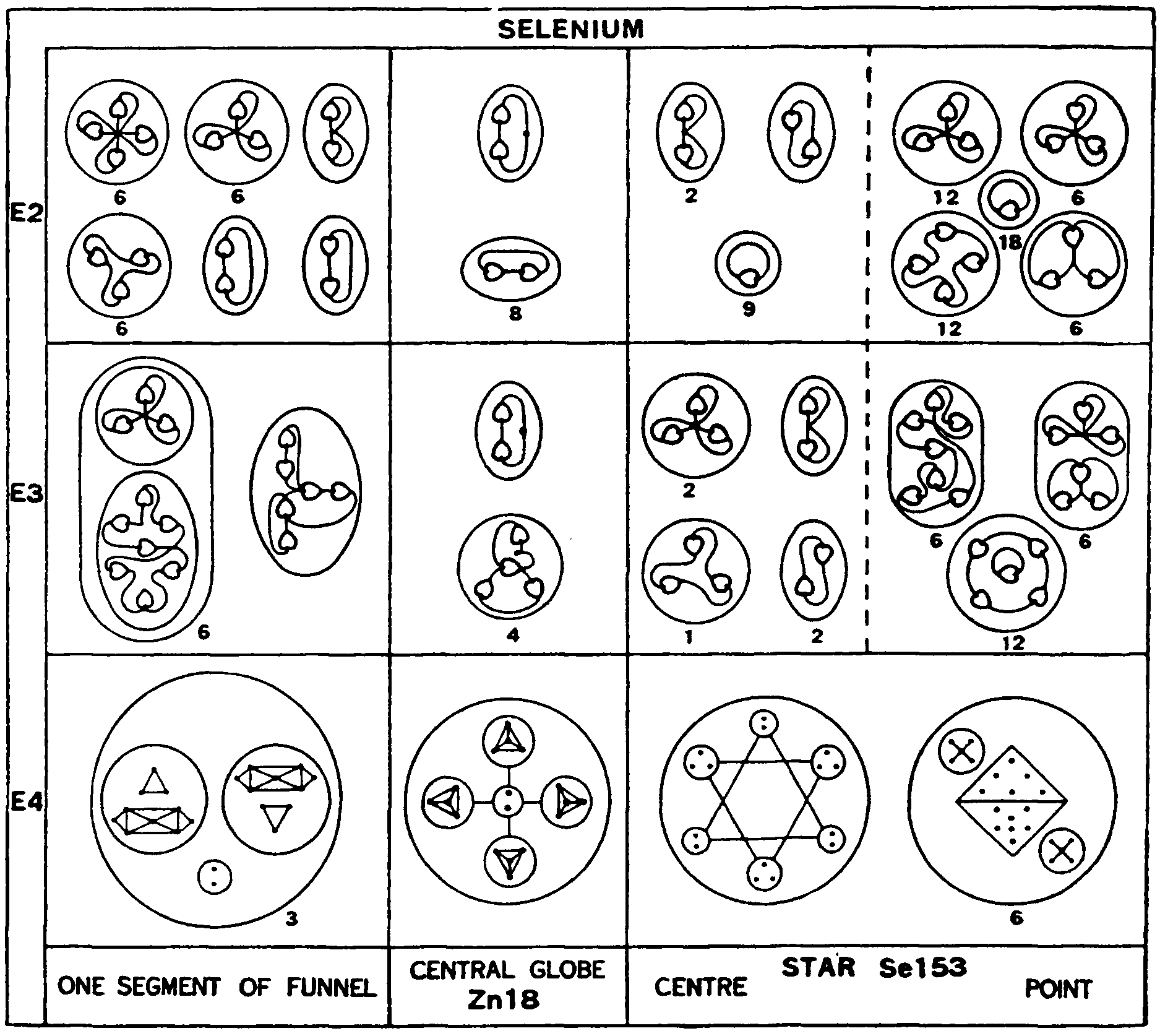
FIG.
73. DISINTEGRATION OF SELENIUM
THE TETRAHEDRON GROUP B 141
DISINTEGRATION OF SELENIUM
Funnels. Each funnel on being liberated sets free three segments on the E4 level. Each segment then liberates three spheres, so that we have nine spheres from each funnel. Fig. 73.
On the E3 level six decads are formed and one hexad. The body with six Anu is formed by combination of three duads.
On the E2 level the decads give twelve triplets and six quartets. The hexad give three duads.
The Star. The star is first liberated as a unit on the E4 level but it soon shoots off into seven bodies. The central portion keeps together and the six points become spheres, within which the two cones, base to base, whirl in the centre and the globes of five Anu circle round them.
On the E3 level all the thirty bodies contained in the star separate from one another, forming twelve quintets, six heptads, six sextets, three triplets and three duads.
The
further disintegration is shown in Fig. 73.
The central globe is similar to that in Zinc, Zn18. This is liberated on the E4 level and is as shown in Fig. 73. On the E3 level it forms tour quartets and a duad. On the E2 level it yields nine duads.
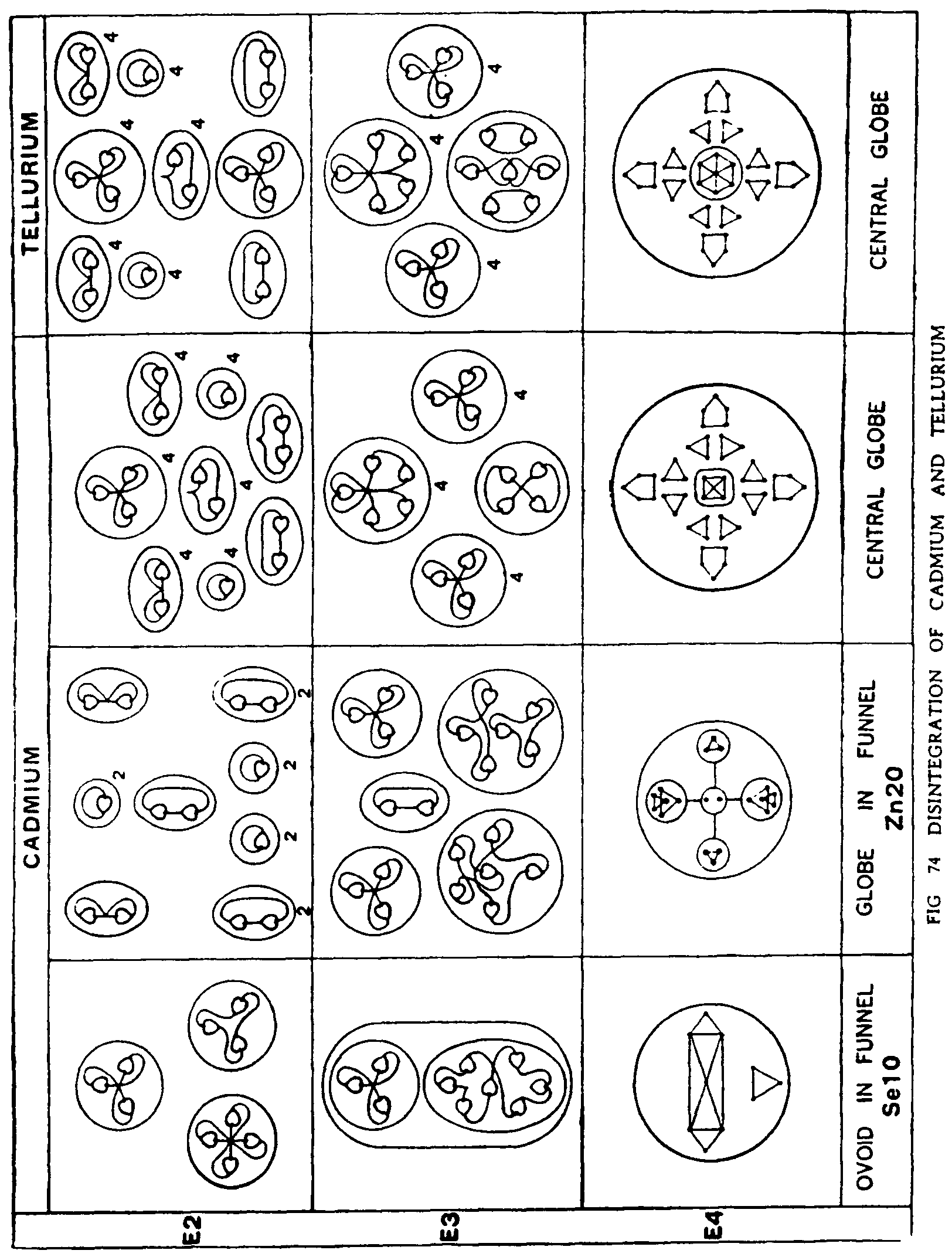
THE TETRAHEDRON GROUP B 143
CADMIUM
Cadmium follows closely on the lines of Zinc. Fig. 74.
Funnels. The globes in the funnels, Zn20, arc those of Zinc, and the pillars are the Zn18' of the Zinc spike.
On the E4 level the ovoids Se10 become spheres, the contained bodies revolving within them. The heptad whirls on a diameter of the sphere, cutting it in half as it were, and the triad whirls round it at right angles.
On the E3 level we have a decad, Se10, and on the E2 level two triads and a quartet.
Central globe. The cross becomes a sphere, but the cruciform type is maintained within it by the relative positions of the contained spheres in their revolution. The subsequent stages are shown in Fig. 74.
TELLURIUM
Tellurium
very closely resembles Cadmium.
Funnels.
The pillars are the same as the rod of Chlorine, C1.19, with a duad
added at the base. The ovoid Se10 is the same as in Selenium and Cadmium,
and follows the same course in breaking up. In the globes in the funnels
a group of four is substituted for the group of two in Zinc.
Central
globe. The cross in Tellurium is identical with that in Cadmium, except
that the centre contains seven Anu instead of four. This disintegrates
as in Fig. 74.
144
OCCULT CHEMISTRY
Fig. 75 shows the Tetrahedron Group B in a condensed form, from which the relations between the elements in the group may be studied.

FIG.
75. THE TETRAHEDRON GROUP B